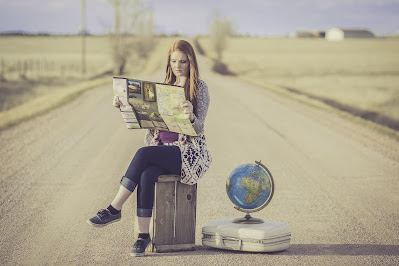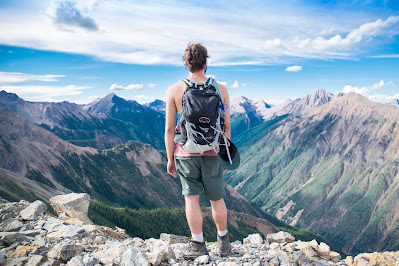Personal safety while travelling
- Get link
- X
- Other Apps
Personal safety while traveling is a concern for many individuals, especially for those who are traveling to new destinations or those who are traveling alone. It is important to be aware of potential safety risks and to take proactive measures to ensure that your trip is as safe and enjoyable as possible. In this article, we will provide tips and strategies for staying safe while traveling, from preparation and planning to personal safety tips and emergency situations.
Before traveling, it is important to conduct thorough research on the destination you will be visiting. This includes looking into any safety concerns in the area, as well as familiarizing yourself with local customs and laws. This can help you avoid any potential misunderstandings or legal trouble while you are away. When planning your itinerary, it is also important to choose safe accommodation and to avoid high-risk areas. Additionally, take care of your personal information by protecting sensitive information and traveling with a limited amount of cash.
Once you are on the trip, it is important to stay aware of your surroundings. This means paying attention to body language, trusting your instincts, and being cautious in unfamiliar environments. Keeping in touch with loved ones is also important, as it provides a sense of security and allows others to check in on you. In case of an emergency situation, it is important to know the local emergency number and to have a plan in place.
There are also several personal safety tips that can be followed while traveling. Protecting your belongings is crucial, as theft is one of the most common safety concerns for travelers. To protect your belongings, carry a minimal amount of valuables and use a secure wallet. When using public transportation, it is important to be aware of pickpocketing and to choose well-lit, crowded vehicles. Maintaining physical safety is also crucial, and this means being cautious when exploring at night and avoiding dangerous areas.
Personal safety while traveling is a crucial aspect of any trip. By conducting thorough research, staying aware of your surroundings, and following personal safety tips, you can ensure that your trip is as safe and enjoyable as possible. Remember to trust your instincts, stay in touch with loved ones, and have a plan in place for emergency situations. With the right preparation and planning, you can have a worry-free and memorable travel experience.
Taking care of personal safety while traveling is a must for anyone who is traveling, either alone or with a group. By researching the destination, planning your itinerary, taking care of personal information, and following personal safety tips, you can ensure that your trip is safe and enjoyable. Remember to stay aware of your surroundings, trust your instincts, and have a plan in place for emergency situations. With the right preparation and precautions, you can have a memorable and safe travel experience.
Preparation before traveling
Preparation before traveling is an essential aspect of ensuring personal safety while on a trip. It is important to take the time to properly research the destination, plan your itinerary, and take care of personal information to minimize potential safety risks. In this article, we will focus on the various aspects of preparation before traveling and how they can help ensure a safe and enjoyable trip.
One of the first steps in preparing for a trip is researching the destination. This includes looking into any safety concerns in the area, as well as familiarizing yourself with local customs and laws. This information can be found through travel websites, guidebooks, and government travel advisories. Knowing about potential safety concerns, such as crime rates and natural disasters, can help you make informed decisions about your itinerary and activities. Familiarizing yourself with local customs and laws can also help you avoid any potential misunderstandings or legal trouble while you are away.
Another aspect of preparation is planning your itinerary. When planning your itinerary, it is important to choose safe accommodation and to avoid high-risk areas. It is also a good idea to have a general understanding of the transportation options available in the area and to plan for alternative routes in case of unexpected circumstances. Additionally, consider purchasing travel insurance, as it can provide peace of mind and financial protection in case of emergencies.
Taking care of personal information is also an important aspect of preparation before traveling. This includes protecting sensitive information, such as passport and credit card numbers, and traveling with a limited amount of cash. Consider using a travel wallet or money belt to keep your valuables secure, and consider keeping copies of important documents in a secure location. Additionally, make sure to inform your bank and credit card company about your travel plans, as this can help prevent potential fraud.
Preparation before traveling is a crucial aspect of ensuring personal safety while on a trip. By researching the destination, planning your itinerary, and taking care of personal information, you can minimize potential safety risks and ensure a safe and enjoyable trip. It is important to take the time to properly prepare before traveling, as it can help prevent unexpected situations and provide peace of mind while you are away. Remember, proper preparation can make all the difference in ensuring a safe and enjoyable travel experience.
During the trip
Personal safety during the trip is of utmost importance, and it is essential to take proactive measures to ensure that your trip is safe and enjoyable. Staying aware of your surroundings, keeping in touch with loved ones, and handling emergency situations are key components of personal safety while traveling. In this article, we will discuss each of these aspects in more detail.
A. Staying aware of your surroundings
Staying aware of your surroundings is one of the most important aspects of personal safety while traveling. This means paying attention to body language, trusting your instincts, and being cautious in unfamiliar environments. To stay aware of your surroundings, it is important to avoid distractions, such as using your phone or wearing headphones. It is also a good idea to keep a low profile, especially when exploring unfamiliar areas. This means avoiding wearing flashy jewelry or carrying large amounts of cash. Additionally, be aware of your surroundings when using public transportation, and choose well-lit, crowded vehicles whenever possible.
B. Keeping in touch with loved ones
Keeping in touch with loved ones is also important for personal safety while traveling. This provides a sense of security and allows others to check in on you. Consider using a communication tool, such as a phone or messaging app, to stay in touch with loved ones. It is also a good idea to inform loved ones of your itinerary and to let them know if your plans change. In case of an emergency, having a trusted person who knows your whereabouts can be invaluable.
C. Handling emergency situations
Handling emergency situations is an important aspect of personal safety while traveling. It is important to know the local emergency number and to have a plan in place in case of an emergency. Consider carrying a small first-aid kit and knowing basic first-aid techniques. Additionally, it is a good idea to know the location of the nearest hospital or medical facility, and to carry contact information for your travel insurance provider.
Personal safety during the trip is crucial for ensuring a safe and enjoyable experience. By staying aware of your surroundings, keeping in touch with loved ones, and handling emergency situations, you can minimize potential safety risks and have peace of mind while traveling. Remember, trust your instincts, be proactive, and take the time to prepare for potential emergencies. With the right preparation and precautions, you can have a safe and memorable travel experience.
Personal safety tips while traveling
Personal safety while traveling is of utmost importance, and it is essential to take proactive measures to ensure that your trip is safe and enjoyable. Protecting your belongings, staying safe while using public transportation, and maintaining physical safety are all crucial components of personal safety while traveling. In this article, we will discuss each of these aspects in more detail.
A. Protecting your belongings
Protecting your belongings is an important aspect of personal safety while traveling. To minimize the risk of theft, it is advisable to carry a minimal amount of valuables, such as jewelry and cash. Consider using a secure wallet or money belt to carry your important documents, such as your passport and credit cards. When carrying a bag, be sure to keep it close to your body and keep it zipped or locked at all times. In crowded areas, be especially mindful of pickpocketing, and keep an eye on your belongings at all times.
B. Staying safe while using public transportation
Using public transportation is a convenient and often cost-effective way to get around while traveling. However, it is important to take safety precautions when using public transportation to minimize the risk of theft or other safety hazards. To stay safe while using public transportation, it is advisable to be aware of pickpocketing, especially in crowded vehicles. Choose well-lit, crowded vehicles whenever possible, and avoid using public transportation late at night when it may be less crowded and more hazardous. When using public transportation, be sure to keep an eye on your belongings and keep them close to your body.
C. Maintaining physical safety
Maintaining physical safety is an important aspect of personal safety while traveling. To minimize the risk of danger, it is advisable to be cautious when exploring unfamiliar areas, especially at night. Avoid venturing into dangerous areas, such as neighborhoods with a high crime rate, and stick to well-lit, well-populated areas whenever possible. Additionally, be mindful of your personal safety when engaging in activities such as hiking, swimming, or exploring remote areas. When engaging in these activities, it is important to take necessary precautions, such as carrying a first-aid kit and informing someone of your whereabouts.
Personal safety while traveling is crucial for ensuring a safe and enjoyable experience. By protecting your belongings, staying safe while using public transportation, and maintaining physical safety, you can minimize potential safety risks and have peace of mind while traveling. Remember, trust your instincts, be proactive, and take the time to prepare for potential emergencies. With the right preparation and precautions, you can have a safe and memorable travel experience.
- Get link
- X
- Other Apps


